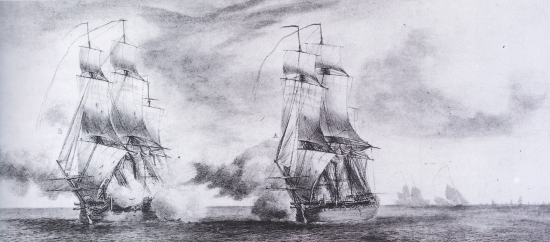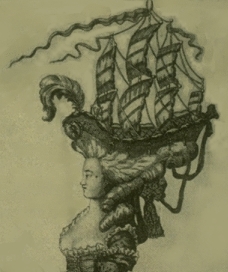
| Battle between the French frigate La Belle Poule [on viewer's right] and the British frigate Arethuse [viewer's left] off the coast of Brest, 17 June 1778. Image is from an etching printed in Navies and the American Revolution edited by Robert Gardiner (1996). Original image is identified as published by Gouaz, no date, in Voyez la Gazette de France, no 51; now part of the Chatham Collection, British Maritime Museum, Greenwich, England. |
On 15 June 1778, the British Admiral Keppel commanded a fleet of twenty-one ships of the line, four frigates, and three smaller vessels cruising off the coast of Brest. Keppel's mission was to prevent the French Toulon fleet, under the French Admiral-general d'Estaing, from joining the main French fleet, home ported at Brest. Actually, the French had successfully deceived the British as to the destination of the Toulon fleet, and d'Estaing's force, which had departed the Mediterranean port nearly two months earlier, was in the West Indies in mid June.
This action marked the first naval combat between French and British forces in the American War for Independence. The French king, Louis XVI, elected to identify this incident as the opening of war between England and France, although a formal declaration was made months later. The French needed this first open breach of peace by a British initiative, in order to have England appear as the aggressor, a necessary condition to apply �Le Pacte de Famille' and draw Spain into the war. This, of course belie the fact that France's February 1778 recognition of the United States (after years of covert assistance to American colonies in rebellion) had already cast France as taking sides in the war.

| The battle is also famous as the subject documented in many contemporary prints, which show the elaborate hair creations adopted by ladies in Parisian high society. It became fashionable for the ladies to wear their hair �� la Belle Poule', which was a large pompadour surmounted by a model of the famous frigate. |
Notes of interest: Navies of The American Revolution, Anthony Preston et al. (London, 1975), p.62, states that Belle Poule was the first French ship to have copper sheathing of its haul in 1777. British began this practice in 1761 with the frigate Alarm (32). La Belle-Poule, was later captured on 11 Jul 1780, off the coast of France, by the Britsh Nonsuch.
This 17 June 1778 naval engagement among a few ships is given brief treatment in the few printed Anglophone publications that address the global scope on the navies during the American War for Independence. The 17 June battle off Brest is usually treated as a small prelude to the more famous, but confusing, combat between French and British fleets known as the �Battle of Ushant' [Isle d'Ouesant] (27 July 1778). One ot the clearest descriptions is in The American Revolution A Global War by R. Ernest Dupuy, Gay Hammerman, and Grace P. Hayes (David McKay, New York, 1977) as part of Chapter 14, "Britain Fights in European Waters" (pp.208-218).
Return to main webpage on French Naval Leaders and the French Navy in the American War for Independence.
Page posted 14 April 2004, revised late the same date.